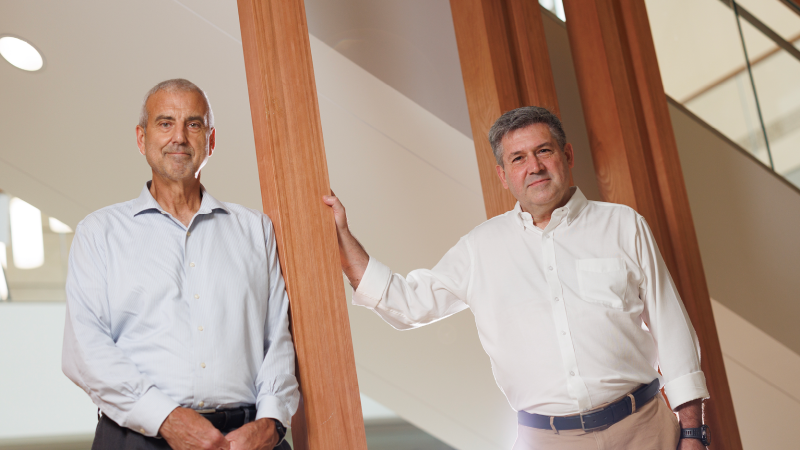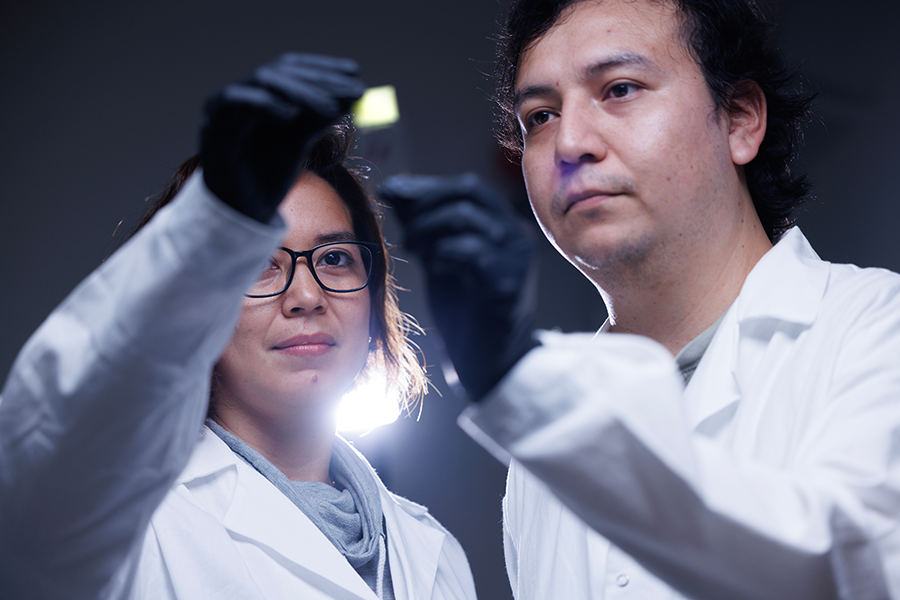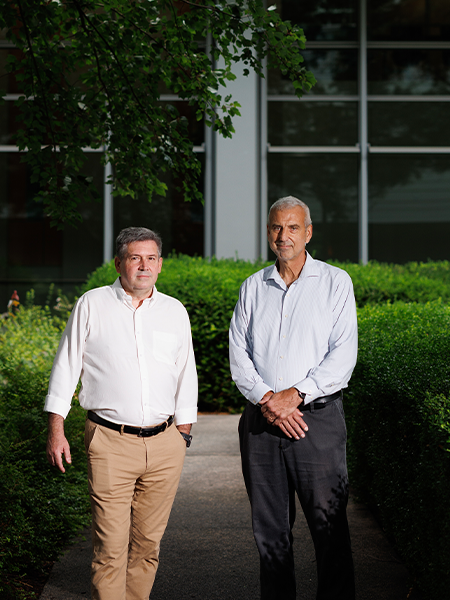
Building Better Immunotherapy
At first glance, the vial nesting in a laboratory tray at Duke University School of Medicine looks like any other. But inside something remarkable is happening. A new kind of cancer-fighting cell is taking shape that might finally crack one of medicine’s most frustrating challenges: how to make immunotherapy work against solid cancer tumors.
José Ramón Conejo-Garcia, MD, PhD, and Scott Antonia, MD, PhD – an immunologist and a lung cancer specialist – are deep in the trenches of the effort. What they’re building together isn’t just another tweak on CAR-T cell therapy, the breakthrough that has transformed treatment for some blood cancers.
They’re creating an entirely new cellular weapon, one that might bypass the barriers that have long made solid tumors nearly impervious to immunotherapy.
Their secret lies in gamma delta T cells drawn not from adult donors or bone marrow, but from umbilical cord blood — the nourishing fluid that supports babies before birth. Never exposed to infections, these pristine immune cells are more adaptable and potent. Duke researchers are engineering the rookie immune cells to fight cancer.
“Gamma delta T cells are one of the lingering mysteries of the immune system,” said Conejo-Garcia, professor in the Duke Department of Integrative Immunobiology. “They’re rare and special and can be used across donors without triggering the dangerous immune clash that we usually worry about.”
In standard CAR-T cell therapy, T cells are taken from a patient, modified to target a specific cancer cell, and then infused back to the patient. They can be very effective, but they also come with serious risks such as graft-versus-host disease when immune cells attack healthy tissue.
Graft-versus-host disease is why today’s CAR-T therapies must be custom-made for each patient. But it turns out, gamma delta T cells collected from cord blood don’t pose that risk. That opens the door to something new: an off-the-shelf, universal cancer cell therapy that could be frozen, stored, and given to any patient the day they’re diagnosed.
That alone could be a game-changer. But Conejo-Garcia and Antonia’s approach goes even further.
They’re building a new kind of CAR-T cell therapy that includes an antibody found not in animals or algorithms, but in a human cancer patient – an immunotherapy success story.
A Human Clue Hidden in a Tumor
The story began when Antonia noticed something striking in pathology reports from a lung cancer clinical trial led by Neil Reddy, MD, at Duke Cancer Institute.
Patients whose cancer journey likely started with a medical scan showing a mass in their lung -- non-small cell lung cancer, the most common form for the disease and one of the deadliest -- had enrolled in the small trial. Usually what follows is surgery, chemotherapy, and long odds. DCI would offer these patients something different.
In the trial patients received an immunotherapy drug, pembrolizumab, before surgery. The strategy was to shrink their cancer tumors and train the immune system to recognize and fight it. But among the de-identified tumor samples, the tissue from one lung cancer patient stood out.

“It was teeming with plasma cells,” said Antonia, a medical oncologist who cares for patients at DCI. These antibody-producing plasma cells are rarely seen in such numbers inside solid tumors. In this case, it wasn’t just a response. It was an immune surge, a dense infiltration that looked less like cancer’s quiet retreat and more like a full-blown immunological uprising.
The infiltration told Antonia, a global leader in the development of immunotherapy for lung cancer, that the patient’s immune system was already recognizing something unique in the tumor. He wanted to know what.
The team examined more than 10,000 plasma cells, one by one, to look for antibodies trained to fight cancer. They found one that locked onto a protein called citrullinated vimentin, a twisted form of protein found inside cells but only pushed to the surface in cancerous conditions.
“When under stress, like a cancer tumor, cells make this altered form and display it on their surface,” said Conejo-Garcia, a Duke Science and Technology Scholar. “And only tumor cells do this not healthy ones.”
That made this protein like a bullseye on cancer cells a perfect target. Conejo-Garcia has built a custom CAR-T cell to go after it, guided by the one-of-a-kind antibody and powered by the newly engineered gamma delta T cells. The result is a cancer-fighting cell trained to hunt down tumors while leaving healthy tissue alone.
Why Cord Blood?
Umbilical cord blood, donated by mothers after birth, can save children and adults with leukemia, lymphoma and other deadly illnesses who need stem cell transplants. It’s also a vital resource for research.
Duke pathologists Joanne Kurtzberg, MD, and Beth H. Shaz, MD, leaders of the Carolinas Cord Blood Bank and Marcus Center for Cellular Cures, are teaming up with immunotherapy researchers to put these powerful cord blood cells to work for even more patients.

The Duke team discovered they could grow and activate tumor-targeting gamma delta T cells from umbilical cord blood more effectively than from adult donors.
The special CAR-T cells with the unique ability to seek out and attack cancer cells are already showing promising effects in lab and animal models, according to findings presented in May at the Annual Meeting of the American Association of Immunologists.
“In mice we see strong tumor control with no damage to vital organs,” Conejo-Garcia said. “Now we’re testing it in immunocompetent models to simulate human biology more closely.”
What excites both researchers most is that the therapy appears to work even in “cold tumors,” ones that don’t provoke an immune response and don’t respond to today’s immunotherapies. That’s because these CAR T-cells aren’t relying on existing immune recognition; they bring their own target, derived from the antibody found in that one remarkable patient.
“This is the kind of collaboration we’re aiming to build by using real-world patient samples to explore biological mechanisms and turn those findings into better patient care,” Conejo-Garcia said.
From Lab to Lifeline
Moving from lab success to a Phase 1 clinical trial requires costly GMP-grade manufacturing, safety testing, and regulatory review. Grants for this kind of translational leap are limited, so they’re exploring industry partnerships and philanthropic support to carry the therapy forward.

“We’re trying to make CAR-T cells work for more patients,” said Antonia. “That’s been a challenge in the field. But now we have a lead, and it started with one patient’s immune system doing something extraordinary.”
Their approach is tumor agnostic meaning it could apply across many types of solid cancers, but the first trials will likely focus on non-small cell lung cancer, the disease that inspired the discovery.
If funding can be secured and all goes well, the first patient could receive these new CAR-T cells in just a few years. The innovative research that has brought us to this point is driven by a cross disciplinary collaboration that’s essential in science.
“I’m a clinician. Jose’s a basic scientist,” said Antonia of the partnership that goes back to 2016 when both worked at Moffitt Cancer Center in Tampa, Florida. “This project only works because we each bring something the other doesn’t. And together, I think we’re building something that could finally change the game.”
Shantell M. Kirkendoll is a senior writer and managing editor for Duke University School of Medicine Strategic Communications.
Eamon Queeney is assistant director of multimedia and creative for Duke University School of Medicine Strategic Communications.
